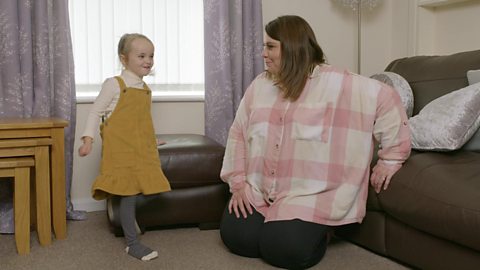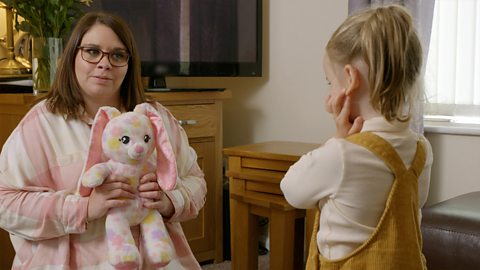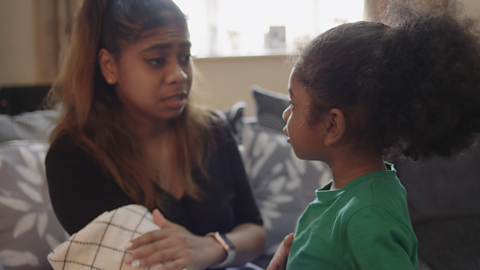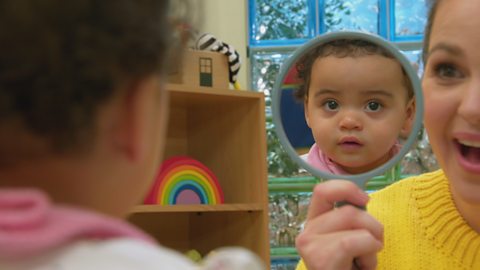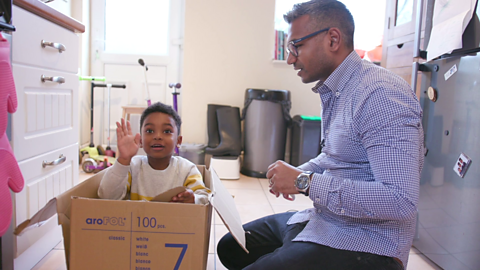So your little one has hosted a lot of teddy bears' picnics? But have they ever stopped to ask how teddy is feeling?
Children will often play out different emotions using their toys and teddies before they know how to use words to express them.
This activity can provide your child with the important words that they will need to verbalise their feelings.
Start by asking how your child's toy feels today, then see where the conversation takes you.
See how important this pretend play is for your child's language and emotional development in the video below.
Amber, how are you feeling today?
Good.
You're feeling good? Do you think baby feels good today?
No, she's feeling sad.
She is feeling sad… Oh no… I wonder why?
Harry's sad.
What was making Harry sad?
The animals.
Oh no, why?
Because they were making noises.
Because they were making noises? What kind of noises do you think they were making?
[Animal noises]
Ooooh! Do you think he's very hungry?
Yeah.
What are they going to eat?
A pear.
A pear? Well done. There you go, Baba. Is he going to eat it?
Yeah.
And once he's eaten his pear, how will he be feeling?
Happy!
Will he? What can we do to make baby feel better?
I'll give her medicine.
Medicine? Oh, she has a bad fever! She has a bad fever?
Yeah… Right down here.
Oh my goodness. So what do you do if she's got a bad fever?
Going to give her medicine. Make her better.
Make her better. I think Moo is very sad, because he doesn't get any pears. Do you think he could have some too?
He can have this bit of it.
That's kind of you.
And he can have this bit.
That's amazing, well done.
How does baby feel now? Baby's feeling good.
She's feeling good? Okay.
How's Harry feeling now?
Happy, because I gave him a really good cuddle Thank you.
You made him smile.
How can pretend play help children talk about their feelings?
- Talking about feelings with toys helps children begin to think about their own emotions and those of other people.
- It gives a them chance to hear you using the words to describe emotions - the more they hear you say the words the better they willunderstand them and eventually use them.**
- Expressing thoughts through pretend play is a great way to encourage children to use longer sentences and tell stories.
- It is a great chance to practice using different grammar, such as the future and past tense.
- Pretend play gives children an opportunity to express their thoughts and point of view.
- This activity creates an opportunity to talk about any underlying fears or feelings your child might have and reduce anxiety.
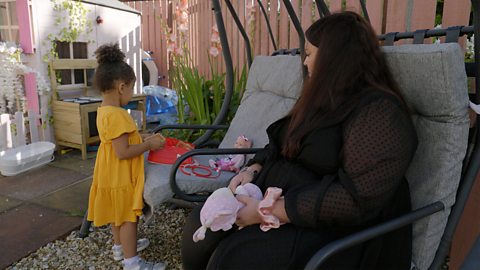
5 more games to play with a teddy
Teddy's are good for more than just cuddling. For your child, playing with a teddy can be magical and also great for their language development.
Here are a couple more ideas to help you make the most of your little one's favourite teddy:
1. Play hide and seek with a teddy
You can play hide and seek with a teddy from when your child is very young. As they get older, you can age up the activity by turning it into a treasure hunt.
Watch our video on setting up a great language-boosting treasure hunt.
2. Have a teddy bear's picnic
Putting on a teddy bear's picnic is a fantastic opportunity for role-playing and developing your child's communication.
You can build in choices ("Does Teddy want tea or juice?"), add in questions ("What food does Teddy like best?") and incorporate the future tense ("What will Teddy do next? What might happen? Where will he go?").
You might have already played this game when your child was younger, but if not, you can find out more here.
3. Teach your child about nighttime routines
Pretend play is a great chance for your child to practice language around routines like bedtime, e.g. 'Night, night, Teddy'.
When children can act out a sequence of pretend play this demonstrates they are ready to use connected sentences. This is a great insight into their readiness for more advanced language.
4. Play the over and under game
Use toys and ask your child to place them in different positions (under their feet, besides their ear, on top of their head) get creative!
As their language get more advanced, you can add in more complex position words.
Try this fun activity with your child!.
5. Learn about body parts
Help your child learn the words of lots of different body parts with their teddy. Add descriptive or sequence words as they get older to make the game more age-appropriate.
Watch our video about this fun and simple game.
This is also a great opportunity to talk about what happens to your body when you have particular emotions - e.g. when Teddy is nervous his tummy feels funny, when he is cross he clenches his hands and feels very hot.


